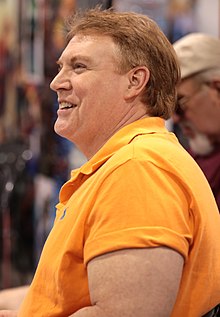Greg Land
Greg Land (* around 1965) is an American comic artist .
Life and work
Greg Land, who is from the American Midwest, started working for a company that specialized in the manufacture of painting supplies while studying at Indiana State University .
In the early 1990s, Land managed to get his first engagement as a professional draftsman with an American independent publisher. After working there for several years on the series StormQuest, Pat Garrahy, one of the senior editors of the largest American comic publisher DC Comics , gave him the job of cover artist for the adventure series Birds of Prey in 1999 . His work on this series turned out to be so popular that he also did the drawings for the "inside" of the notebooks, i.e. the actual stories. After he had put several years of the Birds of Prey in the picture, Land switched to the action series Nightwing , also appearing on DC , which he visualized for several years as the successor to the cartoonist Scott McDaniel .
For the publishing house CrossGen Land took on the drawing duties for the fantasy series Sojourn in 2001 , which he supervised until 2004 and for which he drew a total of 34 issues. After CorssGen had to stop publishing, land switched to Marvel Comics. There he worked again as a cover artist, for example for the miniseries X-Men: The End , but eventually took over the design of the interior of series such as Ultimate Fantastic Four and miniseries such as Black Widow: Home Coming or Ultimate Power .
Some of the more important comic book writers Land has worked with in the past include Jeph Loeb (Ultimate Power) and Chuck Dixon (Birds of Prey, Nightwing).
Controversy
Land's activity as a draftsman is controversial: while his fans praise the photorealism of his pictures in general and the classic beauty of the characters he created on paper in particular, his critics - such as the operator of the Internet project Deconstructing Greg Land - proposed to draw stereotypical, individuality-free figures, whose facial features and facial expressions would practically not differ from one another at all.
As "proof" for this criticism, for example, the faces of women from an X-Men story drawn by Land and a Sojourn story drawn by him were superimposed to show that both figures were identical apart from their hairstyle and color scheme .
In addition, he was even accused of having copied the facial features of famous film actors of his characters, such as the actress Jessica Alba or the actor Hugh Jackman , one to one, possibly even having technically integrated them into his images through scanning programs, which Land himself firmly rejects .
Individual evidence
- ↑ From Polygon to Paper: Resident Evil , by Richard George.
Web links
| personal data | |
|---|---|
| SURNAME | Country, Greg |
| BRIEF DESCRIPTION | American comic artist |
| DATE OF BIRTH | around 1965 |
